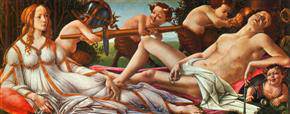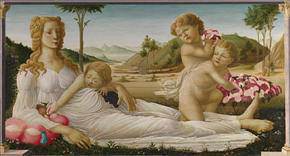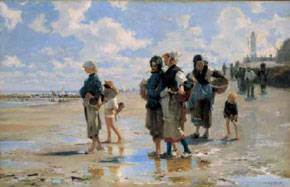

Sandro Botticelli’s ‘Venus and Mars’ (top), painted around 1485, is shown along ‘An allegory’ (bottom), by an unidentified Florentine painter, formerly attributed to Botticelli
Close Examination: Fakes, Mistakes and Discoveries at the NGA The first major exhibition of its kind, Close Examination: Fakes, Mistakes and Discoveries celebrates the remarkable collaboration of scientists, conservators and art historians at the National Gallery. 30 June – 12 September 2010 ]]>
Source: National Gallery, London
Close Examination explores this pioneering work by presenting the varied and fascinating stories behind more than 40 paintings in the National Gallery’s collection. The exhibition is arranged over six rooms, representing some of the major challenges faced by Gallery experts: Deception and Deceit; Transformations and Modifications; Mistakes; Secrets and Conundrums; Redemption and Recovery; and a special focus room relating to Botticelli. The exhibition features works by Raphael, Dürer, Gossaert, Rembrandt and others.
Room 1: Deception and Deceit
Some paintings in the collection raise complex questions of disputed authorship and authenticity. These range from straightforward period copies to modern forgeries created with the intent to deceive. The lengths forgers will go to deceive is shown in Portrait Group. This has been identified as the work of an unknown forger of the early 20th century, imitating the style of Renaissance profile portraits. The National Gallery purchased the painting in 1923, believing it to be an authentic work from the 15th century. Scientific analysis exposed the deception, revealing that the artist had used pigments not available before the 19th century. It also emerged that the top layer had been coated with shellac, a natural resin, to simulate the appearance of age.
Room 2: Transformations and Modifications
The Gallery owns several paintings which, over the course of time, have been modified to satisfy changing tastes or interpretations. A provocative Renaissance depiction of a Woman at a Window, probably 1510–30, was dramatically altered in the 19th century to satisfy more restrained Victorian tastes. The girl’s hair was changed from blonde to brunette, her expression made more innocent and her bodice rendered less revealing. In the 1700s, a painting by an unknown German artist, Portrait of Alexander Mornauer, about 1464–88, was altered to resemble a work by the more famous (and highly collectable) artist Hans Holbein. Microscopic examination of paint sample cross-sections revealed that a layer of blue paint had been applied over the original brown background. The style of the sitter’s hat was also altered. The changes convinced an 18th-century aristocrat that he was buying an authentic Holbein. The Gallery acquired the painting in 1990 and conservators were able to safely remove these additions to return the painting to its original state.
Room 3: Mistakes
This room focuses on the misattribution of paintings, and examines how scientific analysis and connoisseurship can work together to correct past mistakes. A Man with a Skull was acquired by the Gallery in 1845 as a work by Holbein. Even at the time many experts doubted the attribution. Modern dendrochronological analysis to determine the age of the wood panel support has since shown the painting post-dates Holbein’s death in 1543. The exhibition will reveal a new attribution for this painting.
Room 4: Secrets and Conundrums
Despite many triumphs and advances, some paintings remain stubbornly mysterious. For example, it is difficult to exactly recreate the workings of an artist’s studio: the materials and techniques used, or the role of assistants. Close Examination highlights some of the important discoveries made in this area; for instance during recent conservation work on The Virgin and Child with Two Angels, about 1475, experts were able to take a closer look and solve a long-standing conundrum over authorship. Originally acquired as a work by Domenico Ghirlandaio, the painting was later demoted, attributed to the workshop of Andrea del Verrocchio. However, after removing layers of old retouching work, and examining the underdrawing with infrared reflectography, it became clear that Verrocchio himself painted the Virgin, the angel on the left and the landscape in the background, while his assistant, Lorenzo di Credi, painted the angel on the right and the infant Christ.
Room 5: Being Botticelli
At various points in the National Gallery’s history, some works were enthusiastically acquired on mistaken attributions to iconic artists. In June 1874 the Gallery purchased two Botticellis – or so it seemed. One of these (Sandro Botticelli, Venus and Mars, about 1485) is now one of the most beloved paintings in the collection. The other painting (Follower of Sandro Botticelli, An Allegory, probably about 1490–1550) was then thought to be a companion to Venus and Mars. Some even thought it the more desirable of the two. However, this painting was soon discovered to be a pastiche, painted by a follower in the style of the great master. The paintings will be shown side-by-side so that visitors can test their own skills of connoisseurship.
Room 6: Redemption and Recovery
The final room of the exhibition celebrates instances in which the work of great painters has been re-discovered through a combination of scientific analysis, conservation, connoisseurship and art historical research. Until 1991, the whereabouts of Raphael’s original painting of The Madonna of the Pinks, about 1506–7, was an intriguing mystery for art historians. Only copies of the painting were known. However, during a visit to Alnwick Castle in Northumberland, Dr Nicholas Penny spotted an intriguing painting which demanded closer examination. Infrared reflectograms revealed an exquisite underdrawing beneath the paint surface, bearing all the hallmarks of Raphael’s hand. Subtle differences between this underdrawing and the finished painting, particularly in the costume and background landscape, showed the artist had changed his mind as he worked. No copyist wishing to pass a painting off as the original would have departed from his model in such a way. Chemical analysis confirmed that the pigments used were typical of Raphael’s distinctive palette, including some that ceased to be used after the 16th century.
‘Close Examination’ is the first major exhibition to explore the full range of scientific discoveries made by a leading art gallery within its collection. The close working relationship between scientists, conservators and curators constantly yields new and exciting findings while helping us to gain a deeper understanding of important works of art.
Follow us on:


